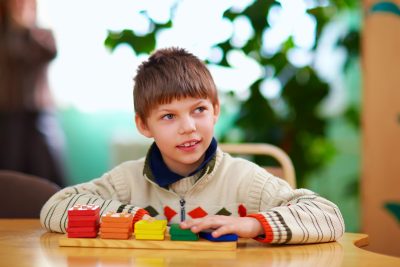Adaptive Play provides fun and engaging ways for children to learn new skills from occupational or physical therapists. Teachers in developmental preschools and kindergartens also make Adaptive Play part of their days. You can too!
Simply put, Adaptive Play is games and toys that work for children with unique physical or mental capacities. Special ways to play pretend, build with blocks, make up games or explore sensory experiences can engage and support children with developmental delays, physical challenges, sight or hearing challenges, or significant emotional/behavioral challenges. In hospitals, children in recovery might be able to “step outside” that bed or room for a while to have some playful fun.
Don’t let the fancy name intimidate you: Adaptive Play doesn’t have to be complicated or expensive. This article provides a few ideas and website links to help you get started. As the person who knows your child best, you may find that you are already creating Adaptive Play opportunities for your child!
By trying the ideas at home, you may also learn some tools and tricks that can be useful at daycare or school. For example, you may find out that certain sensory toys are great distractors, that playdough uplifts a mood or that a tub of play sand stimulates thinking and helps a child become centered.
Adaptive Playtime might include:
- Modified toys, such as Duplo’s instead of Legos
- BIG crayons, pencils, paper…
- Water playtime with bubbles
- A tub of sand, kidney beans, flax seeds with a variety of scoopers or measuring cups
Digging into a sensory tub full of something to scoop and pour can help if your child struggles with large and small muscle or motor movement. Picking things up, holding things steady, touching and smelling the objects also helps with sensory development.
Homemade playdough is another great way to turn “work” into play. Playdough develops muscle movement, touch, sight and smell and inspires the imagination. The Imagination Tree has a recipe for a non-toxic playdough. Your child can help you make it and can choose the colors and the smells!
A Speech-Language Pathologist who specializes in assistive technologies, Lynn Shugars, has published a list of Adaptive Play and Leisure activities online. Here are her “rules:”
- It should be FUN! Don’t turn it into work or it won’t be enjoyable.
- It should be MOTIVATING to the student. (This is often different from what teachers and parents think the student might enjoy).
- Expose a student to many toys and activities to determine what they like.
- Change activities often, but repeating activities is beneficial and highly recommended. This fosters memory skills and allows students to anticipate activities.
- Choose manipulative toys and activities.
There are many websites, Facebook groups and Pinterest pages dedicated to creating great play and learning spaces for children with challenges. Pathyways.org, offers articles and videos about the importance of playtime. Another resource is a website called Growing Hands-on Kids.
Don’t limit yourself to what you read online! Creating toys and activities from everyday items allows children to see those everyday things as fun and usable and stimulates imagination in play. Getting creative with your child will create a model for how to work with objects in the world to keep things interesting and inventive. Engaging your child in the process of creating adaptive toys and activities might even make it easier to take a trip—you’ll find that all kinds of things that are readily available and inexpensive can become the perfect toy!
Go play, and have fun with your awesome kids!

